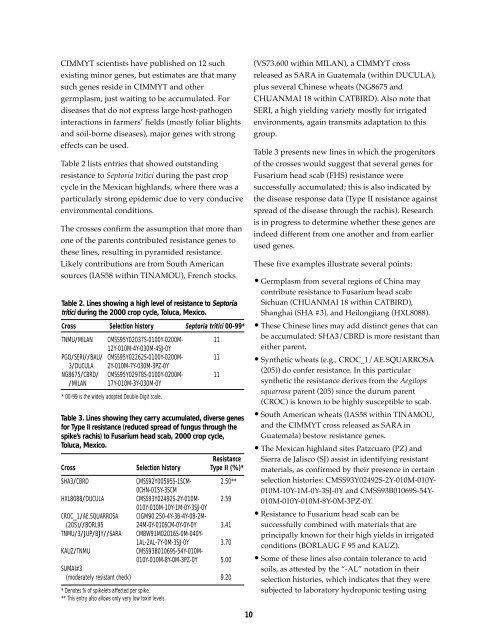Research Highlights of the CIMMYT Wheat Program 1999-2000
Research Highlights of the CIMMYT Wheat Program 1999-2000
Research Highlights of the CIMMYT Wheat Program 1999-2000
You also want an ePaper? Increase the reach of your titles
YUMPU automatically turns print PDFs into web optimized ePapers that Google loves.
<strong>CIMMYT</strong> scientists have published on 12 such<br />
existing minor genes, but estimates are that many<br />
such genes reside in <strong>CIMMYT</strong> and o<strong>the</strong>r<br />
germplasm, just waiting to be accumulated. For<br />
diseases that do not express large host-pathogen<br />
interactions in farmers’ fields (mostly foliar blights<br />
and soil-borne diseases), major genes with strong<br />
effects can be used.<br />
Table 2 lists entries that showed outstanding<br />
resistance to Septoria tritici during <strong>the</strong> past crop<br />
cycle in <strong>the</strong> Mexican highlands, where <strong>the</strong>re was a<br />
particularly strong epidemic due to very conducive<br />
environmental conditions.<br />
The crosses confirm <strong>the</strong> assumption that more than<br />
one <strong>of</strong> <strong>the</strong> parents contributed resistance genes to<br />
<strong>the</strong>se lines, resulting in pyramided resistance.<br />
Likely contributions are from South American<br />
sources (IAS58 within TINAMOU), French stocks<br />
Table 2. Lines showing a high level <strong>of</strong> resistance to Septoria<br />
tritici during <strong>the</strong> <strong>2000</strong> crop cycle, Toluca, Mexico.<br />
Cross Selection history Septoria tritici 00-99*<br />
TNMU/MILAN CMSS95Y02037S-0100Y-0200M- 11<br />
12Y-010M-4Y-030M-4SJ-0Y<br />
PGO/SERI//BAU/ CMSS95Y02262S-0100Y-0200M- 11<br />
3/DUCULA 2Y-010M-7Y-030M-3PZ-0Y<br />
NG8675/CBRD/ CMSS95Y02978S-0100Y-0200M- 11<br />
/MILAN 17Y-010M-3Y-030M-0Y<br />
* 00-99 is <strong>the</strong> widely adopted Double-Digit scale.<br />
Table 3. Lines showing <strong>the</strong>y carry accumulated, diverse genes<br />
for Type II resistance (reduced spread <strong>of</strong> fungus through <strong>the</strong><br />
spike’s rachis) to Fusarium head scab, <strong>2000</strong> crop cycle,<br />
Toluca, Mexico.<br />
KAUZ/TNMU<br />
Resistance<br />
Cross Selection history Type II (%)*<br />
SHA3/CBRD CMSS92Y00595S-1SCM- 2.50**<br />
0CHN-015Y-3SCM<br />
HXL8088/DUCULA CMSS93Y02492S-2Y-010M- 2.59<br />
010Y-010M-10Y-1M-0Y-3SJ-0Y<br />
CROC_1/AE.SQUARROSA CIGM90.250-4Y-3B-4Y-0B-2M-<br />
(205)//BORL95 24M-0Y-010SCM-0Y-0Y-0Y 3.41<br />
TNMU/3/JUP/BJY//SARA CMBW91M02016S-0M-040Y-<br />
1AL-2AL-7Y-0M-3SJ-0Y 3.70<br />
CMSS93B01069S-54Y-010M-<br />
010Y-010M-8Y-0M-3PZ-0Y 5.00<br />
SUMAI#3<br />
(moderately resistant check) 9.20<br />
* Denotes % <strong>of</strong> spikelets affected per spike.<br />
** This entry also allows only very low toxin levels.<br />
(VS73.600 within MILAN), a <strong>CIMMYT</strong> cross<br />
released as SARA in Guatemala (within DUCULA),<br />
plus several Chinese wheats (NG8675 and<br />
CHUANMAI 18 within CATBIRD). Also note that<br />
SERI, a high yielding variety mostly for irrigated<br />
environments, again transmits adaptation to this<br />
group.<br />
Table 3 presents new lines in which <strong>the</strong> progenitors<br />
<strong>of</strong> <strong>the</strong> crosses would suggest that several genes for<br />
Fusarium head scab (FHS) resistance were<br />
successfully accumulated; this is also indicated by<br />
<strong>the</strong> disease response data (Type II resistance against<br />
spread <strong>of</strong> <strong>the</strong> disease through <strong>the</strong> rachis). <strong>Research</strong><br />
is in progress to determine whe<strong>the</strong>r <strong>the</strong>se genes are<br />
indeed different from one ano<strong>the</strong>r and from earlier<br />
used genes.<br />
These five examples illustrate several points:<br />
• Germplasm from several regions <strong>of</strong> China may<br />
contribute resistance to Fusarium head scab:<br />
Sichuan (CHUANMAI 18 within CATBIRD),<br />
Shanghai (SHA #3), and Heilongjiang (HXL8088).<br />
• These Chinese lines may add distinct genes that can<br />
be accumulated: SHA3/CBRD is more resistant than<br />
ei<strong>the</strong>r parent.<br />
• Syn<strong>the</strong>tic wheats (e.g., CROC_1/AE.SQUARROSA<br />
(205)) do confer resistance. In this particular<br />
syn<strong>the</strong>tic <strong>the</strong> resistance derives from <strong>the</strong> Aegilops<br />
squarrosa parent (205) since <strong>the</strong> durum parent<br />
(CROC) is known to be highly susceptible to scab.<br />
• South American wheats (IAS58 within TINAMOU,<br />
and <strong>the</strong> <strong>CIMMYT</strong> cross released as SARA in<br />
Guatemala) bestow resistance genes.<br />
• The Mexican highland sites Patzcuaro (PZ) and<br />
Sierra de Jalisco (SJ) assist in identifying resistant<br />
materials, as confirmed by <strong>the</strong>ir presence in certain<br />
selection histories: CMSS93Y02492S-2Y-010M-010Y-<br />
010M-10Y-1M-0Y-3SJ-0Y and CMSS93B01069S-54Y-<br />
010M-010Y-010M-8Y-0M-3PZ-0Y.<br />
• Resistance to Fusarium head scab can be<br />
successfully combined with materials that are<br />
principally known for <strong>the</strong>ir high yields in irrigated<br />
conditions (BORLAUG F 95 and KAUZ).<br />
• Some <strong>of</strong> <strong>the</strong>se lines also contain tolerance to acid<br />
soils, as attested by <strong>the</strong> “-AL” notation in <strong>the</strong>ir<br />
selection histories, which indicates that <strong>the</strong>y were<br />
subjected to laboratory hydroponic testing using<br />
10

















